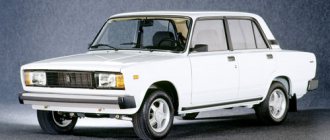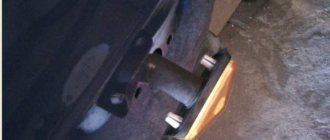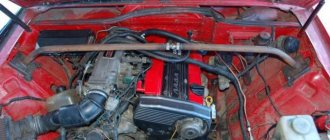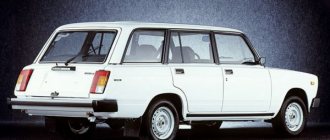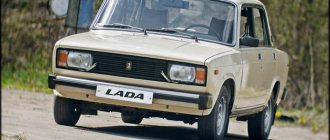LADA 2107 (VAZ-2107 “Zhiguli”) is a Soviet and Russian rear-wheel drive car of the II group of small class with a sedan body, one of the last “classic” models produced at JSC Volzhsky Automobile Plant/AvtoVAZ from March 1982 to April 17 2012. The entire VAZ family of classics begins its history with the Fiat 124.
Model VAZ 2107
History of creation
VAZ 2107 is a modified luxury version of the VAZ 2105 car. The first models were presented to the country's leadership in 1978, and serial production began much later, as was already said in March 1982.
The VAZ 2107 was exported under the names Lada Nova, Lada Riva, Lada Signet, Lada 1500.
In 2001, a model configuration program was developed. VAZ 2107 was available in “norm” and “standard” versions, and for VAZ 21074 – “norm” and “luxury”.
From 2002 to 2012, the VAZ-21070 (modification of the VAZ-2107) was produced in Ukraine (LuAZ, ZAZ and KrAZ). In May 2008, the assembly of the VAZ 2107 was established at Argun in the Chechen Republic. Since March 2011, the production of the “Seven” has been mastered by the Izhevsk Automobile Plant.
In April 2012, the AvtoVAZ concern decided to finally stop production of the classic VAZ2107 sedan. This decision was made due to the greatly decreased demand for this model, as well as due to the acceleration of work in Izhevsk to prepare production for the release of the Lada Granta. The last VAZ 2107 sedan rolled off the assembly line on April 17, 2012. In Egypt, LADA 2107 was assembled until the beginning of 2014.
Production of the 2104 station wagon, unified with the sedan in terms of power plant, exterior and interior of the front part of the body, continued until September 17, 2012.
In March 2022, the analytical agency Autostat conducted a study, according to the results of which the VAZ 2107 sedan became the most popular passenger car in Russia. At the time of the study, this model was driven by 1.75 million Russians.
There are no particularly sharp turns in the history of the VAZ 2107 production. Good exterior and interior design has been positively received for many years. The only major change was the use of distributed injection on this model.
In motorsport
- This car is very popular in Hungary, where it has long become a cult car, and is widely used in motorsport (mainly in rallies);
- 2006—2010. Russian Classic Rally Championship - Grigory Novichikhin;
- 2010—2011. Russian Circuit Racing Championship (RTCC) - No. 77 Vladislav Kubasov, Team: VPK SPORT;
- 2012. BATTLE ROBOT CAR competition in Astrakhan, in which the VAZ-2107 was equipped with a remote control.
- Rally Bohemia 2012 (historic show, SS14 Sychrov) – Lada 21074.JPG
Rally Bohemia 2012 in the Czech Republic
Modifications
- LADA-2107 (engine 2103, 1.5 liters, 8 valves, carburetor)
- LADA-21072 (engine 2105, 1.3 l, 8 valves, carburetor, timing belt drive)
- LADA-21073 (1.7 l engine, 8 valves, mono injection - export version for Europe)
- LADA-21074 (engine 2106, 1.6 l, 8 cl., carburetor)
- LADA-21070 (engine 2103, 1.5 liters, 8 cells, carburetor)
- LADA-2107-20 (engine 2104, 1.5 liters, 8 cells, distributed injection, Euro-2[11])
- LADA-2107-71 (engine 1.4 l., 66 hp. engine 21034 for A-76 gasoline, version for China)
- LADA-21074-20 (engine 21067-10, 1.6 liters, 8 cells, distributed injection, Euro-2)
- LADA-21074-30 (engine 21067-20, 1.6 l, 8 cells, distributed injection, Euro-3)
- LADA-210740 (engine 21067, 1.6 liters, 53 kW/72.7 hp 8 class, injector, catalyst) (2007 onwards)
- LADA-21077 (engine 2105, 1.3 l, 8 cl., carburetor, timing belt drive - export version for the UK)
- LADA-21078 (engine 2106, 1.6 liters, 8 cells, carburetor - export version for the UK)
- LADA-21079 (1.3 liter rotary piston engine, 140 hp, originally created for the needs of the Ministry of Internal Affairs and the KGB). Years of production: 1986—1991.
- LADA-2107 ZNG (engine 21213, 1.7 liters, 8 cells, central injection).
The main motor installed on this model had the following characteristics:
| Manufacturer: | VAZ |
| Brand: | VAZ-2106 |
| Type: | petrol |
| Volume: | 1569 cm3 |
| Maximum power: | 55 kW (75 hp), at 5400 rpm |
| Maximum torque: | 114 Nm, at 3400 rpm |
| Configuration: | in-line |
| Cylinders: | 4 |
| Valves: | 8 |
| Max. speed: | 156 km/h |
| Acceleration to 100 km/h: | 17 s |
| Fuel consumption combined cycle: | 10.5/10.9 (with Weber carburetor) l/100 km |
| Fuel consumption in the urban cycle: | 10.7/12.0 l/100 km |
| Fuel consumption on the highway: | 7.7/8.0 l/100 km |
| Cylinder diameter: | 79 mm |
| Piston stroke: | 80 mm |
| Compression ratio: | 8,5 |
| Supply system: | Carburetor, multipoint injection |
| Valve mechanism: | OHC |
Links
LADA Samara (Sputnik) family VAZ-2108 • VAZ-2109 • VAZ-21099 Lada 110 family VAZ-2110 • VAZ-21106 • VAZ-2111 • VAZ-2112 • VAZ-21123 Family LADA Samara 2
(“Eurosamara”)VAZ-2113 • VAZ-2114 • VAZ-2115 Lada Kalina family VAZ-1117 • VAZ-1118 • VAZ-1119 • VAZ-1119 Sport • Lada Kalina City Lada Kalina 2 family VAZ-2192 • VAZ-2194 Lada Priora family Lada Priora • VAZ-2171 • VAZ-2172 • VAZ-2172 Coupe Lada Granta family VAZ-2190 • VAZ-2191 Lada Largus family Lada R90 • Lada F90 Family on the LADA B/C Vesta Family based on the Renault-Nissan B0 Lada XRAY Minicars VAZ-1111 (“Oka”) • VAZ-1121 • “Gnome” • “Karat” • “Cheburashka” All-terrain Niva family (Lada 4×4) VAZ-2121 • VAZ-21213 • VAZ-2123 • VAZ-2131 • VAZ-2329 • VAZ-1922 (“Bronto-Marsh”) Co-production vehicles Chevrolet Niva • Chevrolet Viva • Lada RF-90 • Nissan Almera • Datsun on-DO • Datsun mi-DO Other cars VAZ-1706 "Shuttle" • VAZ-2113F "Shuttle" • VIS-2348 • VIS 2346 • VAZ-2120 ("Nadezhda") Minivan • "Tarzan" • VIS-23481 • "Tarzan-2" • "Tarzan-3" • APAL-2154 “Stalker” Electric cars VAZ-2801 • VAZ-1801 “Pony” • VAZ-2802 • VAZ-2702 • VAZ-1111E • VAZ 1152 “Elf” • “Rapan” • Lada Golf • Lada Rickshaw • VAZ-10031 “Brontocar” • EL Lada Concept cars VAZ-2151 “Neoclassic” • Lada C Project • Lada C Concept • VAZ-2116 Prototypes VAZ E2121 • VAZ-2103 station wagon • VAZ-1120 Minivan • VAZ-2122 “River” Sports cars Lada-VFTS • Lada-EVA • Lada Revolution
Main differences from LADA 2105
- More powerful 1.5 liter engine. and a power of 77 horsepower (for carburetor versions);
- A modified, often chrome-plated radiator grille with a larger area (in the last years of production, the LADA-2104 was equipped with the same ones for unification purposes);
- The structure of the rear lights has been slightly changed (5-section instead of 6-section in 2105);
- More comfortable front seats with integrated headrests (in the last years of production, LADA 2105, 2104 were equipped with the same ones for unification purposes);
- Some of the cars produced were equipped with a rigidly molded interior headliner and plastic ventilation linings for the rear pillars;
- Modernized front instrument panel (in particular, a tachometer and speedometer with digitization up to 180 km/h were added, as well as an oil pressure indicator (until 1988, after which it was replaced by an econometer);
- Added cold air deflectors (“torpedo”) located in the center. While a stream of hot air can be directed to your feet (through the cabin heater), through these deflectors you can direct a stream of cold air to your face (only at speed, using the pressure of the oncoming air flow);
- Plastic bumpers with chrome trims instead of more massive aluminum ones. In recent years of production, LADA 2105, 2104 were equipped with the same ones for the purpose of unification and reduction in cost;
- Changed shape of the hood (in the last years of production, the LADA 2104 was equipped with the same ones for unification purposes);
- Slightly changed shape of the trunk lid (without stampings), since 2008 they began to install a trunk lid with stampings, like the VAZ 2105, due to the unification of production;
- Some interior details have been changed: door upholstery, door lock buttons, radio panel (“beard”), gearshift knob, steering wheel shape (which later became uniform due to unification);
- The electrical system circuit differs (there are also differences between individual modifications depending on the type of engine).
Fuel consumption
The difference between VAZ 2107 cars of the last years of production
In cars of the last years of production (under the state vehicle recycling program), in order to minimize the selling price, the maximum cost of elements was made relative to previously produced equipment. From what we noticed:
- there are no ashtrays in the rear door trim;
- the door handles inside the cabin are made of molded hard plastic (instead of rubberized material);
- There are no clothes hooks on the ceiling handrails;
- one weak and capricious sound signal “tablet” was used, instead of two “horns”.
The 2010 car was not equipped with a pump. In addition, changes affected the appearance of the “seven”. Instead of a flat trunk lid, a lid with stamping from a VAZ-2105 appeared, and the plastic molding at the bottom of the body disappeared. They refused to paint the door pillars and frames black, and they abandoned the chrome-plated external door handles. Headlight washers and cleaners were no longer installed on cars of recent years of production.
Where is the engine number
Each vehicle model produced at the factory is equipped with an engine with a personal number. So, the engine number on the “seven” is its identification number, which can be used to determine the identity of the stolen car and its history.
The engine number is stamped on the cylinder block on the left side, immediately below the distributor. In addition, the number is duplicated in the summary table, which is attached below the air supply housing. The metal plate contains information about the car, such as model, body number, model and number of the engine unit, equipment, etc.
Tuning
The VAZ 2107, along with other “classic” models, is one of the most tuned Russian-made cars. Its cheapness, on the one hand, and outdated design, on the other, force many owners over time to make efforts to modernize the car.
For example, installing hydraulic compensators on the engine results in a noticeable reduction in engine noise and an increase in timing belt life. We also offer ready-made kits for replacing rear drum brakes with disc brakes.
Due to the large volume of classic cars in use, manufacturers of spare parts offer a lot of finished industrial products to improve consumer properties, and even conveyor suppliers offer “improved” products to replace their own components (for example, a heater motor on bushings from the factory - change to a motor with bearings). The “classics” segment probably has the widest selection of spare parts that differ from the factory equipment.
Notes
- [www.lada.ru/cgi-bin/models.pl Official website of JSC AVTOVAZ.]
- [vmotore.info/cat/vaz/248-lada-2107.html LADA 2107 on the Vmotore.info website]
- Vladimir Shtanov.
[www.vedomosti.ru/newspaper/article/754991/lada-sobiraetsya-v-egipet Lada is going to Egypt] (09/16/2014). - [www.krasz.com.ua/ We collect quality cars].
- [top.rbc.ru/economics/08/05/2008/164313.shtml Zhiguli cars began to be produced in Chechnya]
- Igor VLADIMIRSKY.
[www.autoreview.ru/news/158/122569/ 30 years and one month]. "AUTOREVIEW" (April 18, 2012). - [tass.ru/proisshestviya/1359575 A Lada car plant is burning in Egypt]. Retrieved May 22, 2015.
- [www.autonews.ru/automarket_news/index.shtml?2012/04/17/1727644 The last “seven” rolled off the IzhAvto assembly line] // autonews.ru
VAZ 2107M
The history of the VAZ 2107 has a model that was supposed to be its replacement. This is a VAZ 2107M. It was equipped with a traditional gasoline engine with a volume of 1600 cubic centimeters with distributed injection and a catalytic converter that complies with the Euro 2 environmental standard.
The biggest changes concerned the appearance. The installed round bumpers, headlights, and taillights made the car's shape more aerodynamic and attractive, but this car never went into large production.
VAZ 2107M front view
VAZ 2107M rear view
In the gaming and souvenir industry
A scale model of the VAZ-2107 on a scale of 1:43 in Marx with the number A40 on the bottom was produced from 1984 to 1987. until 2012 it produced numberless models with various stamping options;
The VAZ-2107-20 model was also released in the magazine series “Autolegends of the USSR”, despite the fact that this version was produced after 2001;
03/04/2014 model of the VAZ-2107 Ukrainian Police in 1/43 scale was released as part of the project “Police Cars of the World” (No. 29)
- VAZ A40.jpg
A40
- Vaz 2107 gai 143 model riva143 lada2107.jpg
New version of the traffic police
How is 21074 different?
The main and, perhaps, the only difference from the beds of other sevens of various modifications is in the engine. This is a 1.6-liter (more precisely, 1,569 cc) engine with a cast-iron Fiat block and an aluminum head. Initially, the engine ran only on 93-octane gasoline, but later the compression ratio was lowered to allow the vehicle to be operated on lower grades of fuel. Since the power system still remained carburetor, there was not much difference. The seven happily consumed about 10 liters of fuel in mixed mode.
Seventy-five power and 116 Nm of torque look helpless by modern standards, but then for the country that built communism, it was proletarian chic. Even the Volga was more powerful by only a dozen forces. Toward the end of its career, 21074 still received distributed injection, although it was a different modification, 21074-10, which met Euro2 standards, and the next year an even more advanced seven 21074-20 with an injector appeared, which could meet Euro3 standards. But the injection versions of the six engine completely abandoned 92 gasoline and required only high-octane 95 gasoline.
Sources
- https://aprilvlad.ru/avto-opyt/moshchnost-2107.html
- https://RussoAuto.ru/auto/vaz/vaz-2107
- https://uhta-trans.ru/remont/vaz-2174.html
- https://old-vaz.ru/texnicheskie-xarakteristiki-vaz-2107.html
- https://ladamaster.com/tekhnicheskie-kharakteristiki-vaz-21074
- https://avto-all.com/rossiyskie-avtomobili/vaz-21074-inzhektor-mozhno-smelo-nazvat-obnovlennoy-semerkoy
[collapse]
Carburetor
Carburetors 05 and 07 were specially designed to replace the imported Weber used in the first batches of VAZ-2101 and 2103. The created device was called “Ozone”, and it was given catalog numbers 2105-1107010 and 2107-1107010. A total of 4 modifications were created, indicated by a pair of additional numbers in the part number. For example, "Ozone 2105-1107010-20".
There are 5 signs that allow you to determine how VAZ-2105 carburetors differ from 2107 different Ozone models:
- Cross-section of air and fuel jets.
- Diameter of diffusers.
- Availability of a forced idle economizer (EFI).
- Automatic air damper (choke) drive.
- The presence of a fitting for the vacuum corrector of the ignition distributor.
With the appearance of the VAZ-2108 car on the assembly line, the Ozone carburetor was supplanted by a more advanced design - Solex. She was assigned the following catalog numbers:
- 21053-1107010-20;
- 21073-1107010.
The innovation was a 2-part design (instead of 3), a simple EPHH system (screw-sensor, EM valve, control unit) and the presence of a fitting for returning excess fuel to the tank (“return”). The latter allows you to start the engine if the metering needle is faulty, the floats are incorrectly adjusted and eliminates the formation of air locks between the carburetor and the fuel pump. The latter led to the engine stopping due to lack of fuel.
Total information
ParametersVAZ 2107VAZ 21074VAZ 2107-20VAZ 21074-20
| Weight of the equipped vehicle, kg | 1060 | 1060 | 1060 | 1060 |
| Payload, kg | 400 | 400 | 400 | 400 |
| Permitted maximum weight, kg | 1460 | 1460 | 1460 | 1460 |
| Ground clearance of a vehicle with a permissible maximum weight, with tires 175/70 R13, not less, mm: | ||||
| to the front suspension cross member | 162 | 162 | 162 | 159 |
| to the rear axle beam | 157 | 157 | 157 | 154 |
| Permissible weight of cargo on the additional (top) luggage rack, kg | 50 | 50 | 50 | 50 |
| Maximum speed, km/h: | ||||
| with permissible maximum weight | 148 | 148 | — | — |
| with driver and passenger | 150 | 150 | 150 | 150 |
| Acceleration time from standstill to 100 km/h, s: | ||||
| with driver and one passenger | 17 | 16 | 17 | 16 |
| with permissible maximum weight | 19 | 17,5 | — | — |
| Minimum turning radius along the track of the outer front wheel, m | 5,6 | 5,6 | 5,6 | 5,6 |
| The greatest rise overcome by a car with a permissible maximum weight without acceleration in first gear, % | 36 | 36 | 36 | 36 |
Chassis, steering and braking system
The front suspension of the VAZ 2107 has an independent double wishbone design with two shock absorbers and springs, as well as a stabilizer bar. The rear suspension is dependent with a rigid beam, which is connected to the body through one transverse and 4 longitudinal reaction rods. The suspension design is complemented by two hydraulic shock absorbers with coil springs.
wheels - 5Jxl3H2 (permissible offset 25-30 mm);
tires - 175/70R13 (165/70R13).
The steering mechanism of the VAZ 2107 is a globoidal “worm” driven by a double-ridge roller (gear ratio 16.4). Drive – three-link (2 lateral symmetrical rods, middle symmetrical rod, pendulum arm, swing arm, bipod).
The VAZ 2107 brake system has a foot (foot) drive through a vacuum booster. Its design also includes an emergency sensor and a brake fluid pressure regulator in the rear wheel drive. The parking (hand) brake is activated by a cable that engages the rear wheel chocks. The rear wheels are equipped with a drum-type brake mechanism.
The brake mechanism of the front wheels has a classic disc design with automatic clearance adjustment.
